Decor
How to Incorporate an Old School Desk Into Decor
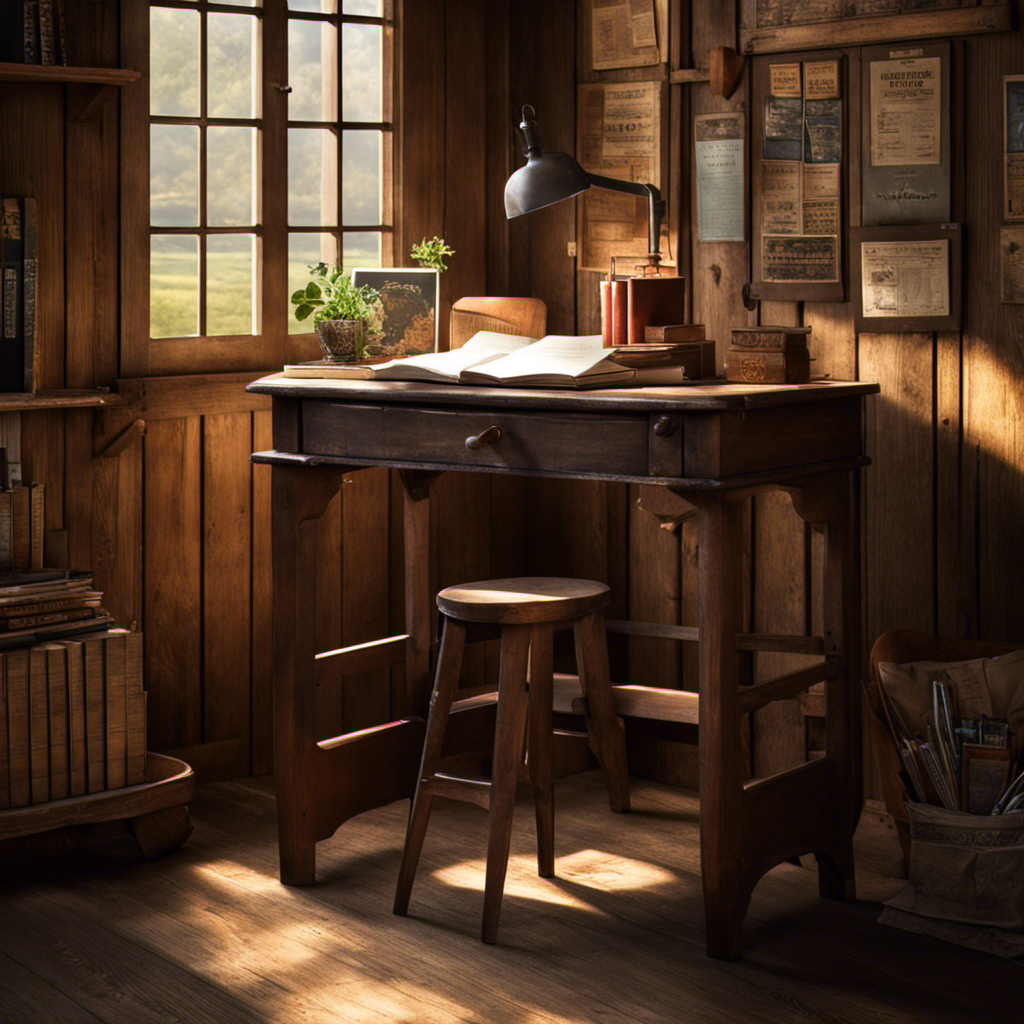
Were you aware that including a classic school desk in your interior design can bring a sense of vintage character to any room?
In this article, I’ll share my top tips and creative ideas for repurposing and styling an old school desk.
From choosing the perfect desk to restoring and refinishing it, I’ll guide you through the process step by step.
Get ready to discover how this nostalgic piece of furniture can bring both functionality and style to your modern home.
Key Takeaways
- Consider the size, style, and condition of the desk when choosing the perfect old school desk.
- Explore different options to find a desk that adds charm and functionality to your space.
- Repurpose the old school desk into a vanity, mini bar, or plant stand for a unique touch.
- Incorporate the desk into modern decor by considering the color scheme and accessorizing with vintage items.
How to Choose the Perfect Old School Desk for Your Space
When choosing the perfect old school desk for your space, you’ll want to consider the size, style, and condition of the desk.
Finding the right size desk is essential to ensure it fits seamlessly into your room. Measure the available space and consider how much surface area you need for your work or study activities.
Additionally, think about the desk’s material and design. A sturdy wooden desk can bring warmth and character to your space, while a metal desk can add a sleek and industrial touch. Consider the overall style of your room and choose a desk that complements it.
Whether you prefer a vintage, rustic, or modern look, there’s a wide range of old school desks available to suit your taste. Take your time exploring different options and select a desk that not only fits your needs but also adds charm and functionality to your space.
Creative Ways to Repurpose an Old School Desk
Try thinking of unique ways you can give new life to that vintage classroom table. Instead of letting it gather dust in the attic, why not transform it into a functional and stylish piece of furniture? With a little creativity and some DIY skills, you can upcycle that old school desk into something truly special. Here are a few ideas to get you started:
| Upcycling Idea | DIY Project |
|---|---|
| Turn it into a vanity | Add a mirror and some storage to create a beautiful vanity for your bedroom or bathroom. |
| Convert it into a bar | Repurpose the desk into a mini bar by adding shelves for bottles and glassware. |
| Transform it into a plant stand | Give your plants a stylish new home by repurposing the desk as a plant stand. |
These are just a few examples of how you can breathe new life into an old school desk. Let your imagination run wild and see what unique creations you can come up with!
Tips for Restoring and Refinishing an Old School Desk
To restore and refinish an old school desk, start by sanding down the surface to remove any existing paint or finish. Restoration techniques for an old school desk can bring new life to a piece of furniture with sentimental value. Here are three tips to help you restore and refinish your old school desk:
-
Clean the desk thoroughly: Before starting any restoration work, make sure to clean the desk properly. Use a mild cleaner and a soft cloth to remove dirt, dust, and grime from the surface.
-
Repair any damage: Inspect the desk for any cracks, chips, or loose parts. Use wood glue to fix any broken pieces and sand down any rough edges.
-
Choose the right finish: When it comes to refinishing, you have various options. Consider staining the desk to enhance its natural beauty or painting it to match your decor. Don’t forget to apply a protective coat to ensure durability.
Styling Ideas for Incorporating an Old School Desk Into Modern Decor
If you want to give your space a unique and vintage touch, consider using an old school desk as a stylish and functional addition.
Styling an old school desk into modern decor can be a fun and creative project.
One of the first things to consider is the color scheme. You can either keep the desk’s original color for a more authentic look or give it a fresh coat of paint to match your existing decor.
For a bold and vibrant look, choose bright and bold colors like turquoise or yellow. If you prefer a more subtle and elegant look, opt for neutral colors like white or gray.
To add a touch of nostalgia, accessorize the desk with vintage items like an antique typewriter or retro desk accessories.
Organizational Hacks for Maximizing Storage With an Old School Desk
Maximize your storage space by utilizing the various compartments and drawers of your vintage desk. With a little creativity and some DIY desk organizers, you can transform your desk into a functional and organized workspace. Here are three ideas to help you maximize the functionality of your desk:
-
Use drawer dividers: By adding dividers to your desk drawers, you can separate and categorize your supplies, making them easier to find and access. This not only saves space but also keeps everything neat and organized.
-
Hang a pegboard: Install a pegboard on the wall above your desk to create additional storage space. You can hang hooks, baskets, and shelves to hold office supplies, notes, and other essentials. This not only keeps everything within reach but also adds a touch of creativity to your workspace.
-
Repurpose containers: Instead of tossing out old containers, repurpose them as desk organizers. Tin cans, mason jars, and shoeboxes can be painted or decorated to match your desk decor. Use them to hold pens, pencils, paper clips, and other small items.
Frequently Asked Questions
What Are Some Popular Alternative Uses for an Old School Desk Besides Using It as a Traditional Desk?
Popular repurposing ideas for an old school desk, besides using it as a traditional desk, include transforming it into a stylish vanity, a chic bar cart, or a unique entryway table. Get creative with upcycling and add a touch of vintage charm to your decor.
Are There Any Specific Materials or Tools Needed for Restoring and Refinishing an Old School Desk?
What materials and tools are needed to restore and refinish an old school desk? Sandpaper, paint or stain, a paintbrush, and a screwdriver are essential. But what if you could transform it into a stylish vanity or a charming entryway table?
Can an Old School Desk Be Incorporated Into Outdoor Decor or Is It Best Suited for Indoor Use Only?
An old school desk can be creatively repurposed for outdoor uses. With a little imagination, it can be transformed into a charming outdoor table or a unique planter stand, adding character to your outdoor decor.
How Can I Ensure That an Old School Desk Fits in With My Existing Furniture and Overall Design Aesthetic?
To ensure that an old school desk fits in with my existing furniture and overall design aesthetic, I can get creative by using it as a plant stand or styling it as a vanity. Attention to detail is key!
Are There Any Specific Tips for Maximizing Storage With an Old School Desk in Small Spaces?
To maximize storage with an old school desk in small spaces, I suggest utilizing the drawers and compartments for organizing supplies. You can also add storage containers or shelves above or beside the desk for additional space.
Conclusion
In conclusion, incorporating an old school desk into your decor can be a creative and stylish way to add character to your space. By choosing the perfect desk, repurposing it in unique ways, and restoring it to its former glory, you can create a standout piece that will be the envy of your guests.
With the right styling ideas and organizational hacks, you can seamlessly blend the old with the new, resulting in a visually stunning and functional addition to your modern decor.
Fun fact: Did you know that vintage furniture sales have increased by 200% in the past decade? This shows that people are increasingly appreciating the charm and uniqueness of incorporating old school desks and other vintage pieces into their homes.
- About the Author
- Latest Posts
Introducing Charles, the Editor in Chief at ByRetreat, whose passion for interior design and editorial excellence elevates every remote workspace to new heights. With his keen eye for detail, impeccable taste, and expertise in design, Charles brings a wealth of knowledge and creativity to the ByRetreat team.
As the Editor in Chief of a renowned lifestyle blog, Charles has honed his skills in curating captivating content and staying up-to-date with the latest trends in interior design. His deep understanding of aesthetics and the power of storytelling through design enables him to create remote workspaces that are not only visually stunning but also rich in personality and meaning.
Decor
Learn How to Repurpose a Vintage Picnic Basket Into a Table in 5 Easy Steps
Just in time for outdoor entertaining, transform a vintage picnic basket into a one-of-a-kind table in 5 easy steps – learn how!
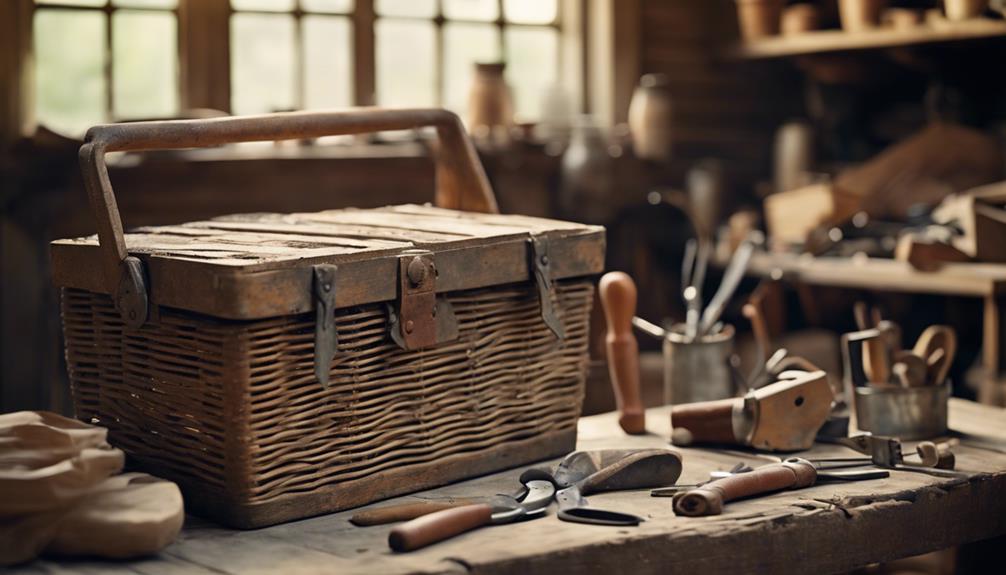
We're giving new life to an old vintage picnic basket by transforming it into a unique table in 5 easy steps. First, we prepare the basket by cleaning, inspecting, and removing unwanted parts. Next, we sand and paint the basket for a fresh look. Then, we add a wooden tabletop surface, attach table legs and a shelf, and finally, add decorative touches to complete the transformation. With these simple steps, we can turn an old picnic basket into a functional piece of decor. Now, let's get started and uncover the details of this creative upcycling project.
Key Takeaways
• Prepare the vintage picnic basket by cleaning, inspecting, and removing old hardware to ensure a sturdy foundation for the transformation.
• Sand and paint the basket to give it a fresh look, applying a protective sealant to preserve the paint.
• Attach a wooden tabletop surface to the basket, measuring and sanding the wood to fit securely and complement the basket's style.
• Securely attach table legs and a shelf to the basket, ensuring stability and even spacing for a functional table.
• Add decorative touches, such as a French transfer, chalk paint, or distressing, to create a unique and functional piece of decor.
Prepare the Vintage Picnic Basket
Let's get started by giving our vintage picnic basket a thorough cleaning to remove any dirt or debris that's accumulated over the years. We want to make sure it's spotless before we begin our repurposing project.
As we clean, we'll inspect the basket for any damage or loose parts that need to be fixed before we can transform it into a table. We'll remove any existing hardware or accessories that may hinder our transformation process.
Depending on the basket's condition, we might need to contemplate sanding or painting it to give it a fresh look before converting it into a table. We want to make certain our vintage picnic basket is sturdy and stable enough to support the weight of items placed on it once repurposed into a table.
Sand and Paint the Basket

We're ready to give our vintage picnic basket a fresh new look by sanding and painting it. This step is important in repurposing our basket into a unique table.
| Step | Task | Purpose |
|---|---|---|
| 1 | Sand the basket | Remove imperfections and old finish |
| 2 | Prime the surface | Guarantee paint adhesion |
| 3 | Apply paint | Transform the basket's appearance |
| 4 | Add protective sealant | Preserve paint and add shine |
We'll start by sanding the basket to eliminate any existing finish or imperfections. Next, we'll apply a primer to prepare the surface for painting and ensure better adhesion. Then, we'll apply a coat of paint in our desired color to transform the basket's appearance. After the paint dries, we'll consider adding a protective sealant to preserve the paint and give the basket a polished look. By following these steps, we'll be able to give our vintage picnic basket a fresh new look that's ready for its new life as a table.
Add a Wooden Tabletop Surface
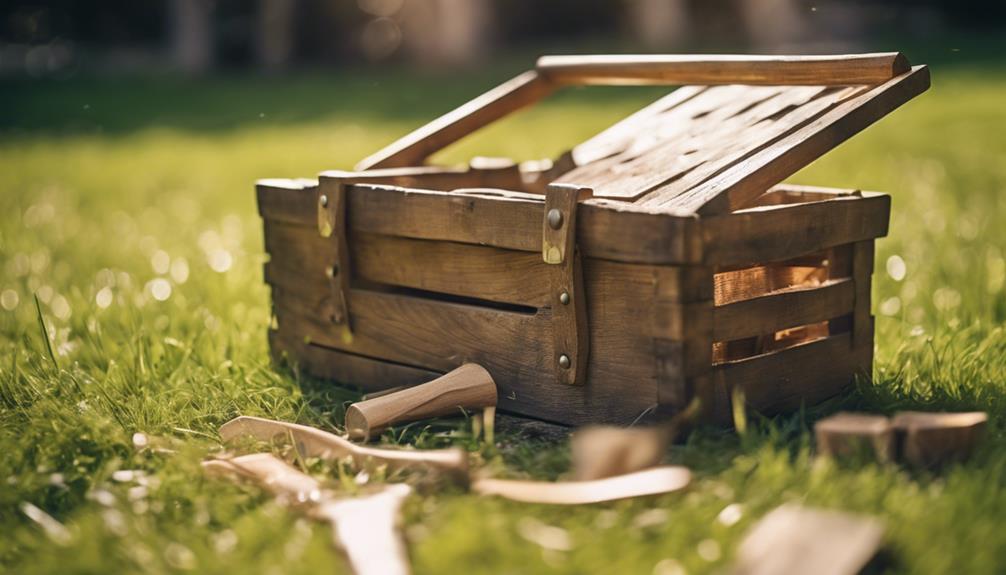
We measure the dimensions of the vintage picnic basket to determine the perfect size for our new wooden tabletop surface. With these measurements in hand, we head to the hardware store to purchase a pre-cut wooden board or have one custom-cut to fit the top of the basket securely.
Once we've our wooden board, we sand it to smooth out any rough edges and apply a stain or paint that complements the aesthetic of the vintage picnic basket. This guarantees a cohesive look and feel for our upcycled table. After the stain or paint dries, we attach the wooden tabletop securely to the basket using screws or adhesive, ensuring stability and durability.
With the wooden tabletop surface in place, our repurposed vintage picnic basket is transforming into a functional and stylish table. We're one step closer to having a unique piece of furniture that's perfect for indoor or outdoor use.
Attach the Table Legs and Shelf
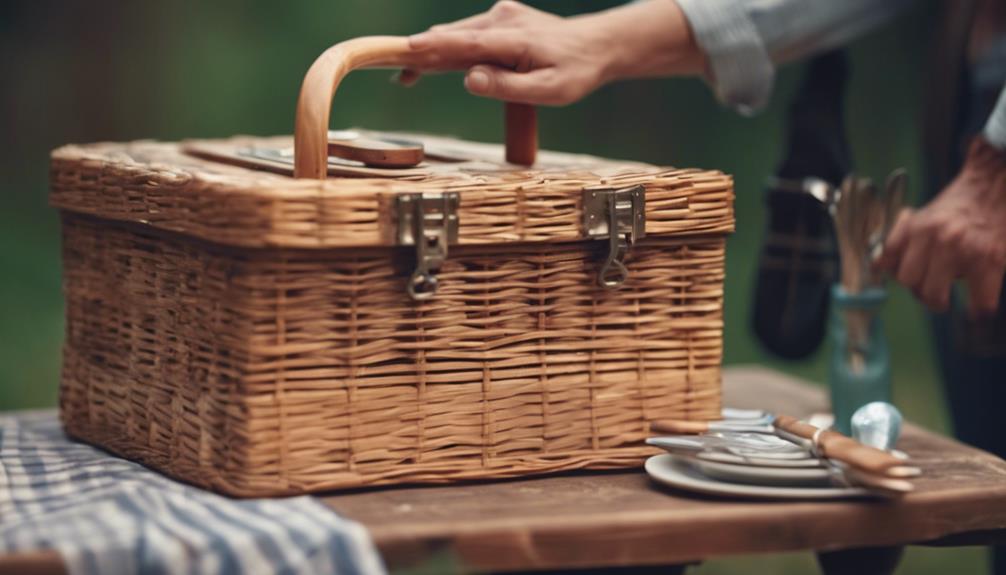
With our wooden tabletop surface securely in place, we can now focus on adding the table legs and shelf to complete the transformation of our vintage picnic basket into a functional table.
To attach the table legs, we'll use screws and a screwdriver to secure them to the bottom of the vintage picnic basket. It's crucial to make sure the legs are evenly spaced and level to provide stability for the table.
Here's a summary of the key steps to attach the table legs and shelf:
- Securely attach the table legs to the bottom of the vintage picnic basket using screws and a screwdriver.
- Add a shelf to the vintage picnic basket table by attaching it to the interior using brackets or screws.
- Double-check the stability of the table legs and shelf to make certain they're secure and level.
Once the legs and shelf are securely attached, our vintage picnic basket transforms into a functional and stylish table, perfect for displaying decorative items or storing essentials.
Add Decorative Touches and Finishing

Adding the perfect finishing touches to our vintage picnic basket table involves mixing functionality with aesthetic appeal. We've worked hard to get to this point, and now it's time to make our upcycled picnic basket shine!
To start, we'll add a French transfer to give our table a vintage touch. We'll secure our chalk paint with a clear matte spray to guarantee durability and protect our hard work. For a rustic look, we can distress the basket with sandpaper, revealing the beauty of the underlying wood.
If we want to make our table truly unique, we can add personal touches like numbers or other embellishments. The finishing touches are what take our picnic basket upcycle from functional to fabulous.
With a little creativity, our repurposed table can become a beautiful piece of functional decor, perfect for storage, display, or as a centerpiece in our home. By combining style and practicality, we'll create a one-of-a-kind piece that showcases our DIY skills and adds character to any room.
Frequently Asked Questions
What Can I Do With a Vintage Picnic Basket?
We're faced with a great question: what can we do with a vintage picnic basket? Well, we're thrilled to explore the possibilities!
With a little creativity, we can breathe new life into this nostalgic treasure. We can transform it into a unique side table, nightstand, or even a functional decorative piece. The options are endless, and we're enthusiastic to uncover the hidden potential in this vintage find.
How to Fill a Picnic Basket?
We're about to pack the mother of all picnic baskets!
When it comes to filling a picnic basket, we start with the essentials: blanket, plates, utensils, cups, napkins, and food. We use containers and bags to organize and protect items inside.
Don't forget a cutting board, knife, corkscrew, and other necessary tools. And, of course, we pack a small cooler for perishable items, sunscreen, bug repellent, and a trash bag for a comfortable picnic experience.
What Would You Put Into Your Picnic Basket?
When we're packing our picnic basket, we prioritize the essentials. We include sandwiches, snacks, fruits, and drinks, along with utensils, plates, cups, and napkins.
To guarantee a comfortable outdoor dining experience, we add a picnic blanket, sunscreen, and bug spray.
For entertainment, we bring games like cards, frisbees, or a ball.
And to capture memories, we don't forget our camera and portable speaker.
How to Pack a Picnic Hamper?
When packing a picnic hamper, we make sure to include essentials like a blanket, plates, utensils, and a corkscrew.
We select easy-to-transport food items like sandwiches, salads, and fruits, and store them in containers or resealable bags to keep them fresh.
We also add eco-friendly disposable items like bamboo plates and biodegradable napkins to reduce waste.
Conclusion
As we step back to admire our handiwork, the vintage picnic basket's rustic charm shines through in its new life as a one-of-a-kind table.
The wooden tabletop's warm glow complements the basket's distressed finish, while the sturdy legs provide stability and a touch of modernity.
The result is a functional work of art that whispers stories of summers past, inviting us to gather 'round and create new memories.
- About the Author
- Latest Posts
Introducing Ron, the home decor aficionado at ByRetreat, whose passion for creating beautiful and inviting spaces is at the heart of his work. With his deep knowledge of home decor and his innate sense of style, Ron brings a wealth of expertise and a keen eye for detail to the ByRetreat team.
Ron’s love for home decor goes beyond aesthetics; he understands that our surroundings play a significant role in our overall well-being and productivity. With this in mind, Ron is dedicated to transforming remote workspaces into havens of comfort, functionality, and beauty.
Decor
Create a Faux Wood Grain Finish
Nailing the art of faux wood grain finishing requires precision, patience, and the right techniques to achieve a remarkably realistic look.
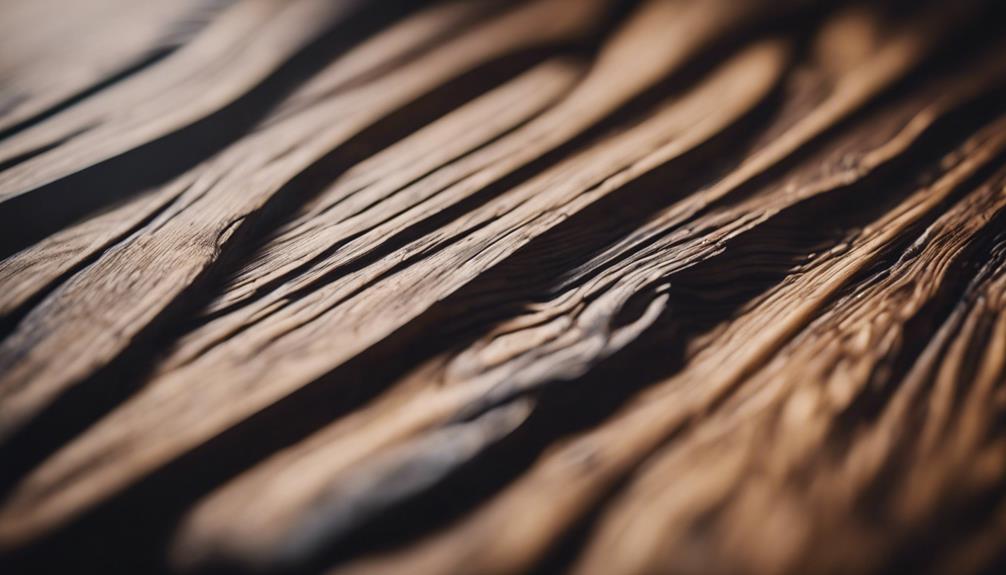
We're about to master the art of faux wood grain finishing, requiring attention to detail and the right tools. Start with a smooth surface, sanding with 320-grit sandpaper, and wiping off dust. Choose high-quality brushes, glazes, and specialized tools, like wood graining brushes, for realistic effects. Apply a yellow or orange base coat, sanding and priming for adhesion. Then, use a wood graining brush to create natural patterns, experimenting with comb-like tools for textures. As we continue, we'll uncover the secrets to blending colors, adding textures, and sealing the finish, revealing a remarkably realistic wood grain effect that's sure to impress.
Key Takeaways
• Start with a smooth surface by lightly sanding with 320-grit sandpaper and wiping off dust for a flawless finish.
• Choose high-quality brushes, glazes, and specialized tools carefully to achieve realistic wood grain patterns.
• Apply a yellow or orange interior paint as the base coat, using long brush strokes for a wood-like effect.
• Use a wood graining brush to create natural patterns, maintaining consistent brush strokes for realism and authenticity.
• Blend multiple coats of gel stain to achieve a realistic wood grain effect, mimicking natural grain patterns and textures.
Preparing the Surface
As we begin our faux wood grain finish project, we need to start with a smooth surface, so we'll lightly sand the area to create a solid foundation for our paint and glazes. This is important because proper surface preparation is essential for the success and durability of our faux wood grain finish.
We'll use a 320-grit sandpaper to achieve a dull finish that helps the paint adhere better. After sanding, we'll wipe off any dust with a damp, lint-free cloth to guarantee a clean surface. This step is essential, as a well-prepared surface will help our paint and glazes mimic the look of natural wood effectively.
We can't stress enough how important it's to get this step right, as it sets the stage for the rest of our project. By taking the time to properly prepare our surface, we'll be rewarded with a beautiful, long-lasting faux wood grain finish that looks like the real deal.
Choosing the Right Tools
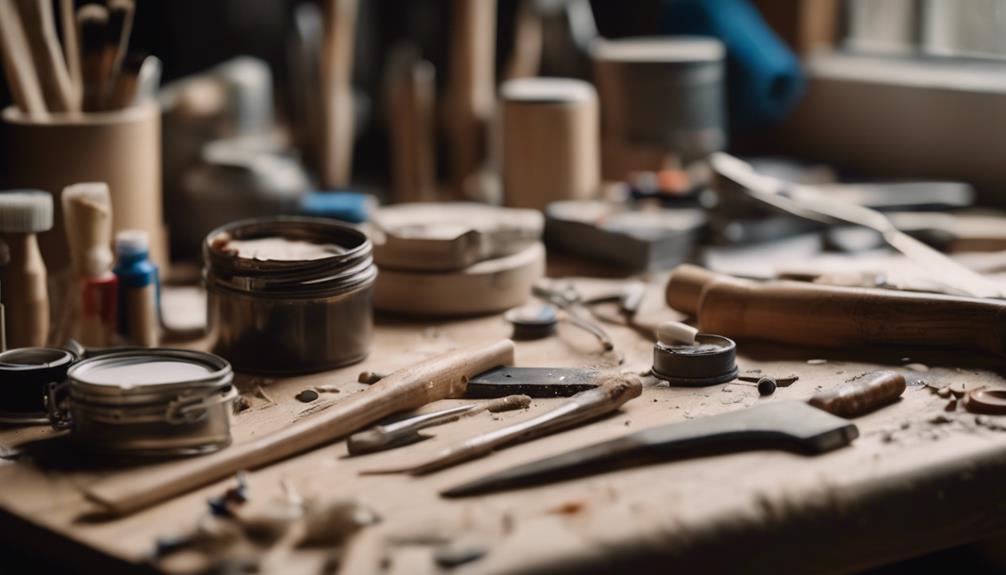
As we progress with our faux wood grain finish project, we need to select the right tools for the job.
We'll explore the key criteria for choosing the best brushes, why paintbrush quality matters, and how surface preparation is crucial for achieving a realistic wood grain effect.
Tool Selection Criteria
Mastering the art of creating a convincing faux wood grain finish requires carefully selecting our tools. We understand that the correct brushes, glazes, and specialized tools are crucial in achieving realistic results.
When aiming for a painted finish that captures the authenticity of wood, we carefully choose various sizes of brushes to produce different wood grain patterns and textures. A specially designed wood graining brush with a curved shape and rings is instrumental in creating lifelike effects.
We also explore the use of glazes, whether they're pre-made or self-mixed, to attain the desired finish. Moreover, we contemplate using comb-like tools to add extra effects and detailing to the faux wood grain finish.
Practicing on a sample surface before tackling the final piece is vital to perfecting the technique and final outcome. By selecting the right tools and honing our technique through practice, we can achieve a faux wood grain finish that closely resembles the real thing. Armed with the appropriate tools and a bit of practice, we can produce professional-looking results that are sure to impress.
Paintbrush Quality Matters
We settle on high-quality paintbrushes with fine bristles, specifically designed for faux wood grain painting, to guarantee we capture the intricate textures and patterns that make our finish look authentic. When it comes to creating realistic wood grain textures, paintbrush quality matters. We've learned that investing in high-quality brushes makes a significant difference in the final appearance of our faux wood finish.
Here are some key takeaways to keep in mind when selecting paintbrushes for faux wood grain painting:
- Fine bristles: Essential for capturing intricate textures and patterns.
- Specific design: Look for brushes designed specifically for faux wood grain painting.
- Stiff bristle brushes: Ideal for applying gel stains and blending colors seamlessly.
- High-quality brushes: Ensure smooth application and professional-looking results.
Surface Prep Essentials
Before applying our faux wood grain finish, we meticulously prepare the surface with the right tools to guarantee a flawless base for our masterpiece.
We begin by using 320-grit sandpaper for surface prep, achieving a smooth and dull finish on the furniture surface.
Next, we prime the surface evenly with Zinsser Bulls Eye 123 primer, establishing a strong bond between the primer and our faux wood grain finish.
We differentiate between the interior paint in yellow/orange hue for the base color and gel stain for creating the wood grain effect. To maintain precision, we employ separate paintbrushes for primer and gel stain application.
After sanding, we make sure the surface is smooth and ready for the next step, ensuring a realistic and professional-looking faux wood grain finish.
With the right tools and surface prep essentials, we set ourselves up for success in achieving a convincing wood grain finish. By following these steps, we can be confident that our masterpiece will turn out exactly as envisioned.
Applying the Base Coat
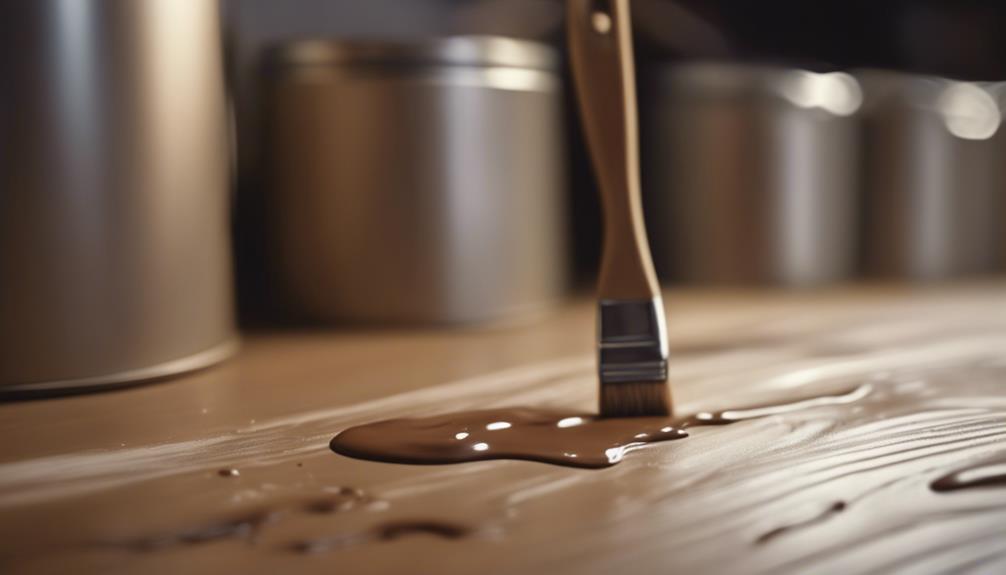
As we move forward with applying the base coat, we need to ponder our base coat options carefully, as this initial layer sets the tone for the entire faux wood grain finish.
We'll explore the importance of choosing the right base coat color to achieve a realistic wood appearance, as well as the essential preparation steps to guarantee a smooth application process.
Base Coat Options
We'll start by selecting a suitable base coat color, typically a yellow or orange interior paint, to provide a warm foundation for our faux wood grain finish. This base coat serves as the foundation for our faux wood grain, enhancing the realism of the final finish.
To achieve a realistic wood-like effect, we'll apply the base coat with long brush strokes in one consistent direction, mimicking the natural grain pattern of real wood.
Here are some key considerations when choosing a base coat:
- Color: Yellow or orange interior paint provides a warm foundation for the faux wood grain finish.
- Application: Apply the base coat with long brush strokes in one consistent direction to create a wood-like effect.
- Evenness: Make sure the base coat is evenly applied and fully dried before proceeding with the next steps in the faux wood grain painting process.
- Influence: The base coat not only provides the background color but also influences the overall appearance and depth of the faux wood finish.
Preparation Essentials
Now that we've selected our base coat color, we need to prepare the surface to guarantee a smooth, even application. This vital step ensures our faux wood grain finish turns out realistic and stunning.
To begin, we'll sand the surface to create a smooth base for our faux finish. This removes any imperfections and provides a clean slate for our paint.
Next, we'll apply a primer to make sure proper adhesion of the base coat. This helps prevent peeling or flaking down the line.
With our surface prepared, we can finally apply our chosen base coat color. For a realistic wood grain effect, we'll use long brushstrokes in one direction. Our yellow or orange hue will mimic the undertones of wood, providing a natural starting point for our faux finish.
After applying the base coat, we'll let it dry completely before moving on to the next steps in our wood grain painting process.
Creating the Wood Grain Pattern
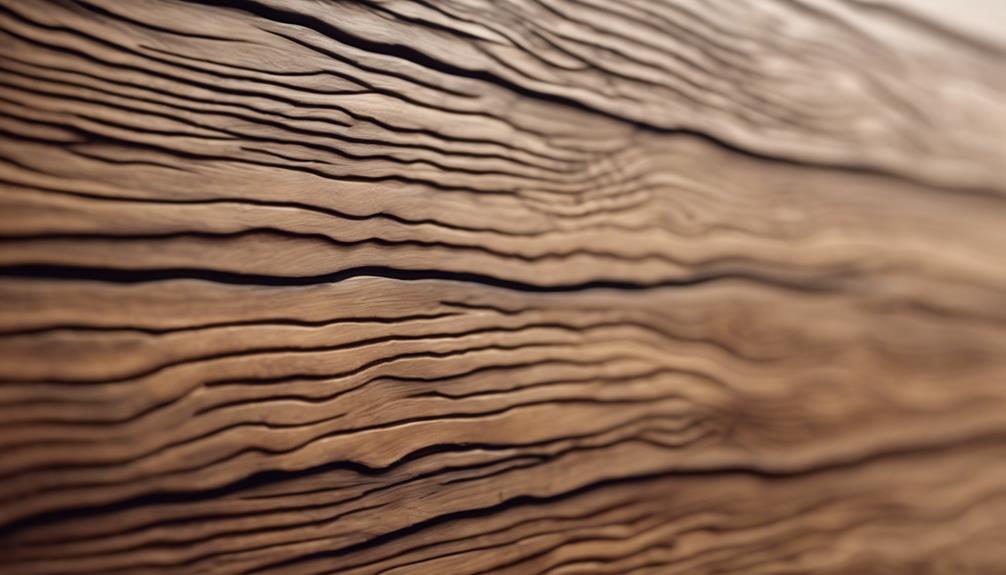
With a wood graining brush in hand, we begin creating the wood grain pattern by applying consistent, smooth strokes in a single direction. This helps to mimic the natural flow of wood fibers, creating a realistic wood grain effect.
Here are some essential tips to keep in mind when creating the wood grain pattern:
- Use the curved shape of the wood graining brush to accurately mimic natural wood grain patterns.
- Maintain consistent brush strokes in the same direction to create a realistic wood grain effect.
- Experiment with comb-like tools to add additional textures and effects to the faux wood grain finish.
- Blend and soften the finish as needed to achieve a seamless and natural-looking wood grain pattern.
Adding Color and Texture
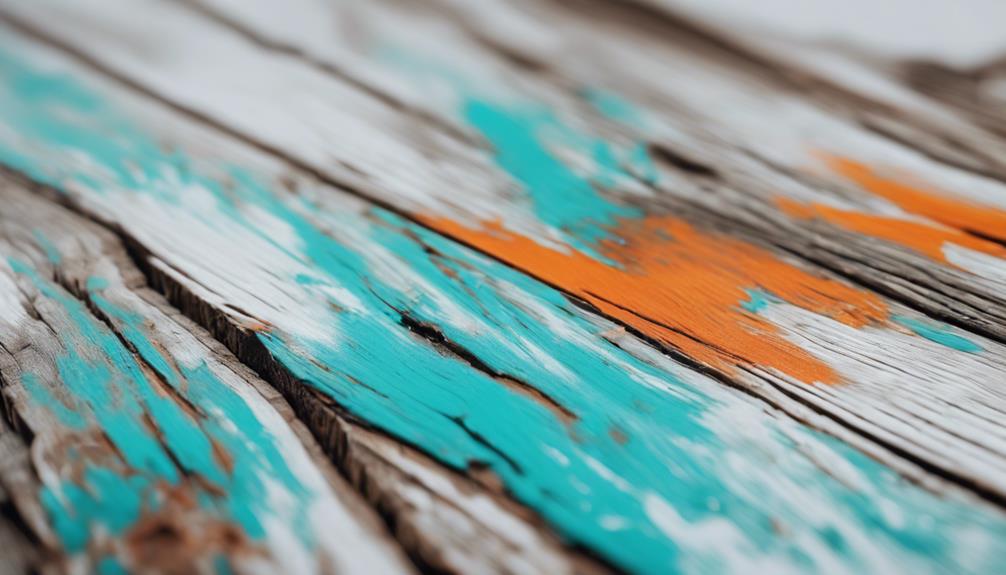
We secure depth and realism to our faux wood grain finish by combining a base color with gel stain, carefully blending multiple coats to achieve a rich, natural-looking effect.
By applying the gel stain in smooth, long strokes, we can mimic the natural grain patterns of wood.
The key to a realistic wood grain effect lies in the blending of multiple coats of gel stain. We must blend carefully, as the direction and blending of paint strokes determine the unique faux wood grain pattern on the surface.
To secure a smooth base for our faux wood grain finish, we may need to apply thick consistency primer quickly and evenly. As we work, we're careful to maintain a consistent texture and color tone to create an authentic wood look.
Sealing the Finish
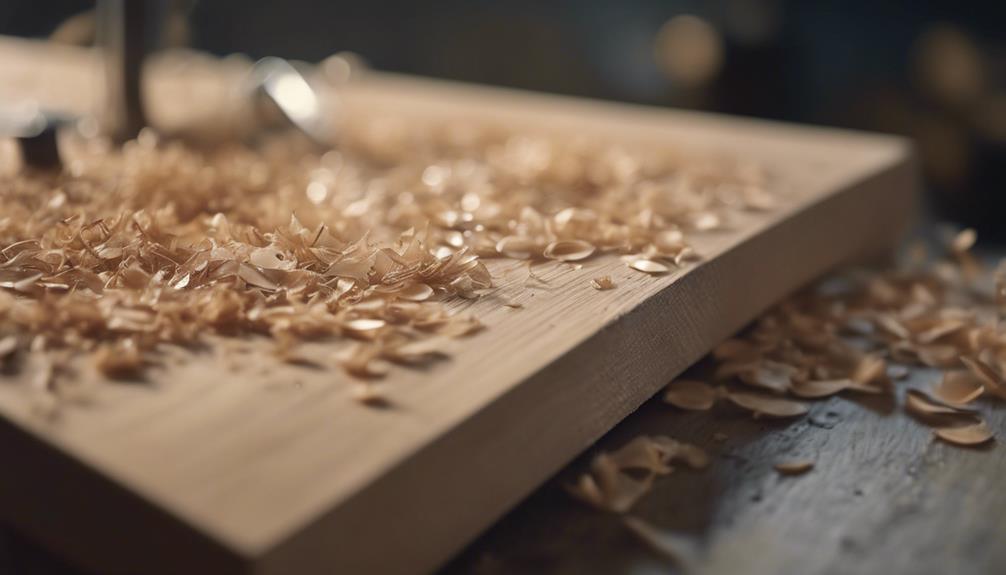
One essential step remains: sealing our beautifully crafted faux wood grain finish to safeguard it against wear and tear. By doing so, we guarantee our hard work doesn't go to waste. Sealing protects the painted surface, enhancing its durability and making it easier to maintain.
Here are some key points to take into account when sealing our faux wood grain finish:
- Choose the right sealer: Select a clear topcoat or wax based on the desired sheen level, such as satin, semi-gloss, or high-gloss.
- Durability is key: A sealer provides a smooth, protective barrier, making our faux wood grain surface more resistant to wear and tear.
- Enhance the appearance: Sealing enhances the wood-like appearance, making it more realistic and visually appealing.
- Easy maintenance: Proper sealing ensures our faux wood grain surface remains easy to clean and maintain.
Frequently Asked Questions
How to Wood Grain Effect?
To achieve a wood grain effect, we use specialized tools and techniques. We employ a wood graining brush with a curved shape and rings to mimic natural patterns.
Applying glaze, either premade or self-mixed, helps create the faux wood grain effect. Brush strokes should follow the same direction for consistency.
We also experiment with comb-like tools for unique variations.
How to Make MDF Look Like Wood Grain?
'Painting a masterpiece of deception' is our goal when making MDF look like wood grain.
To start, we sand the surface with 320-grit sandpaper, creating a smooth canvas.
Then, we prime it with Zinsser Bulls Eye 123, ensuring a strong foundation.
Next, we apply a yellow/orange base coat, followed by gel stain in smooth strokes, blending multiple coats to achieve a realistic wood grain finish that's sure to fool the eye.
Is There Such a Thing as Paint That Looks Like Wood?
We're glad you asked!
Yes, there are paints specifically designed to mimic the look of wood grain. These paints often contain special additives or textures to create a realistic wood appearance. They come in a variety of colors and finishes to imitate different wood types. With proper application techniques, the resemblance to natural wood grain can be quite convincing.
How Do You Simulate Wood Grain on Plastic?
We've all seen those cheap, plastic planters that scream 'fake wood.' But, imagine transforming them into authentic-looking wooden masterpieces.
To simulate wood grain on plastic, we use a wood grain tool or fine paintbrush to create realistic patterns. For instance, take a plastic picture frame – we'd apply a wood-like base coat, then mimic natural wood grain directions and characteristics using varying shades and techniques.
Conclusion
As we master the art of creating a faux wood grain finish, we've discovered a world of possibilities.
By preparing the surface, choosing the right tools, and applying the base coat, we've set the stage for a realistic wood grain pattern.
With added color and texture, our creation comes alive.
Finally, securing the finish guarantees a durable, long-lasting result.
With patience and practice, we can replicate the beauty of natural wood, transforming ordinary surfaces into extraordinary works of art.
- About the Author
- Latest Posts
Introducing Ron, the home decor aficionado at ByRetreat, whose passion for creating beautiful and inviting spaces is at the heart of his work. With his deep knowledge of home decor and his innate sense of style, Ron brings a wealth of expertise and a keen eye for detail to the ByRetreat team.
Ron’s love for home decor goes beyond aesthetics; he understands that our surroundings play a significant role in our overall well-being and productivity. With this in mind, Ron is dedicated to transforming remote workspaces into havens of comfort, functionality, and beauty.
Decor
10 Creative Plant Sconce Styling Ideas
Unleash your green thumb and discover the art of plant sconce styling with these inspiring ideas that will elevate your space's ambiance.

We're always on the lookout for innovative ways to refresh our living spaces, and clever plant sconce styling is one of the most effective ways to do so. Combining different plant species, textures, and colors is a great starting point. Vines like Pothos and Philodendron create a cascading effect, while trailing plants like String of Pearls add a whimsical touch. Geometric plant arrangements and modern air plant holders can infuse spaces with contemporary energy. Repurposing vintage farm tools and experimenting with unconventional materials like ceramic, glass, metal, and wood can also elevate our styling game. As we explore these creative ideas, we're excited to uncover even more unique ways to bring nature indoors.
Key Takeaways
• Combine different plant species, textures, and growth patterns to create unique and visually appealing sconce displays.
• Use vines like Pothos and Philodendron to create a cascading effect and add elegance to sconce styling.
• Experiment with texture and color combinations by mixing wood, metal, and ceramic elements to elevate sconce displays.
• Incorporate trailing plants like String of Pearls for a whimsical touch and to add a playful vibe to sconce styling.
• Repurpose vintage farm tools or use modern air plant holders to add a touch of uniqueness and personality to sconce designs.
Mixing Plants in Sconces
When we combine different plant species in a sconce, we open up a world of creative possibilities, and the result is often a visually appealing and dynamic display. By mixing plants with varying colors, textures, and growth patterns, we can add interest to the sconce arrangement.
For instance, combining plants with different light and water requirements allows for a diverse and balanced look. We can also incorporate trailing, upright, and compact plants in sconces to create a layered and dimensional aesthetic.
Experimenting with a variety of plant sizes and shapes creates a harmonious and personalized sconce design. Whether we're creating a wall hanging or a freestanding sconce, mixing plants is an effective way to add visual interest to indoor plants.
Cascading Effect With Vines

By incorporating vines into our plant sconces, we can create a breathtaking cascading effect that adds a touch of elegance to any room. Vines are ideal for hanging plant sconces, as they can adapt well to these types of planters.
Popular vine choices like Pothos, Philodendron, and Hoyas are perfect for achieving the cascading look in sconces. These versatile plants can thrive in hanging planters, making them ideal for creating a lush and green display.
The cascading effect of vines in sconces can help soften the lines of a room and bring a touch of nature indoors. Moreover, vines like String of Pearls or String of Hearts can add a unique and whimsical touch to our plant sconces with their trailing growth habit.
Texture and Color Combos
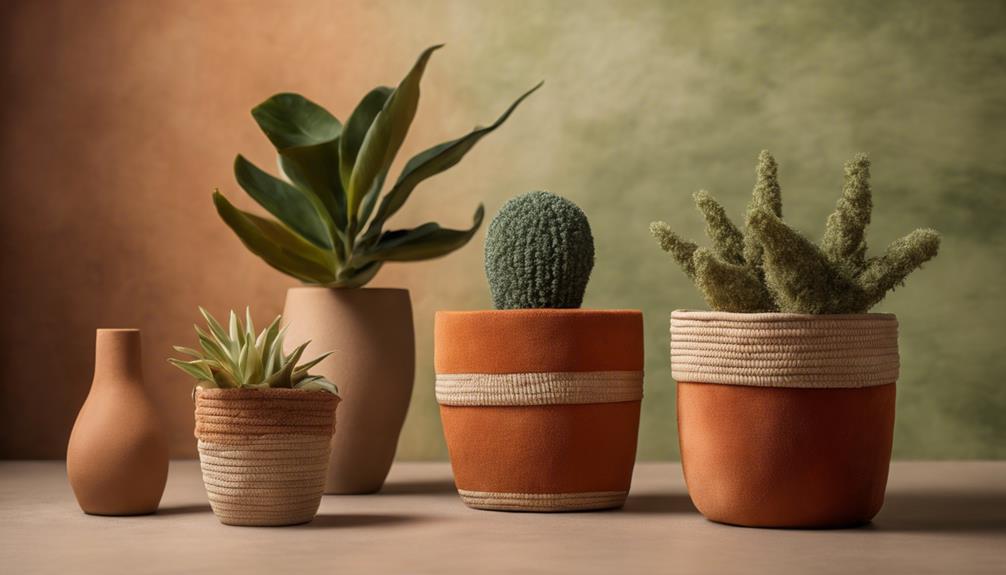
We can elevate our plant sconce game by thoughtfully combining different textures and colors to create a visually appealing display. By mixing wood, metal, and ceramic in our wall sconces, we can create an interesting visual contrast that draws the eye.
Additionally, combining a variety of plant colors such as vibrant greens, deep purples, and bright yellows can add depth to the sconce display. Pairing succulents with colorful flowering plants can create a visually striking and balanced composition in plant sconces.
We can also experiment with a monochromatic color scheme, using varying shades of green to evoke a sense of harmony and tranquility. This thoughtful approach to texture and color combos can take our plant sconce styling to the next level.
Trailing Plants in Sconces

Adding trailing plants to our sconces injects a playful, effortless vibe into our space, as they cascade down the wall in a lush, organic display. These plants are perfect for indoor spaces, thriving in various conditions, making them a versatile choice for sconce styling.
One of the greatest benefits of using trailing plants in sconces is their low-maintenance requirements. They're easy to propagate and maintain, ensuring our wall decor remains lush and vibrant. Trailing plants add a whimsical touch to any space, elegantly trailing down walls, creating a unique and visually appealing addition to our indoor plant collection.
As a unique element of wall decor, they can instantly elevate the ambiance of a room. By incorporating trailing plants into our sconces, we can create a beautiful, organic display that's both effortless and stunning. With their versatility and ease of care, it's no wonder trailing plants are a popular choice for sconce styling.
Geometric Plant Sconce Designs
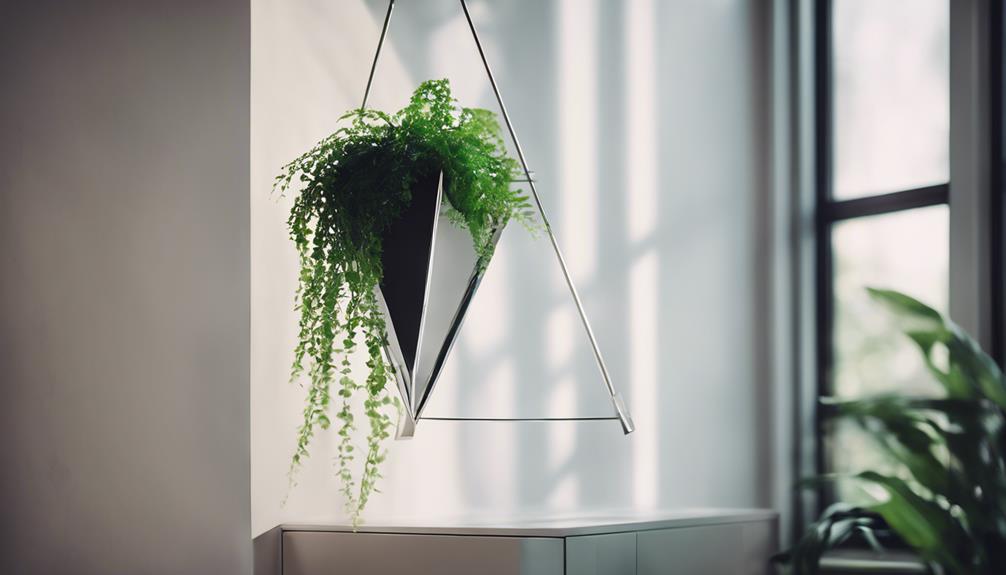
As we explore geometric plant sconce designs, we're drawn to the unique visual appeal of angular plant arrangements that add a touch of modernity to any space.
The incorporation of modern geometric patterns in these sconces creates a striking contrast with the organic beauty of the plants.
Angular Plant Arrangements
Geometric plant sconce designs featuring angular plant arrangements bring a modern, sleek touch to any room, infusing it with a sense of contemporary sophistication. We love how these designs incorporate geometric shapes like triangles, squares, and hexagons to create a visually appealing and structured display of greenery.
By incorporating plants into geometric shapes, these sconces add a touch of sophistication and complexity to any space. The angular plant arrangements in these sconces create a unique way to showcase plants in a stylish and artistic manner.
We appreciate how geometric plant sconce designs offer a modern and sleek way to display plants, making them a great addition to any modern home or office. The angular lines and shapes of these sconces create a beautiful contrast to the natural curves of the plants, making them a standout piece in any room.
Modern Geometric Patterns
We're drawn to modern geometric patterns in plant sconce designs because they infuse a space with a dynamic, contemporary energy. These geometric plant sconce designs feature modern patterns and shapes, incorporating elements like triangles, hexagons, and diamonds.
This style offers a stylish way to showcase plants in a unique and eye-catching manner, adding visual interest and depth to the overall decor. When mounted on a wall, geometric plant sconces create a striking display that becomes a focal point in any room.
The patterns and angles of geometric designs provide a perfect balance between nature and modern aesthetics in indoor spaces. By incorporating geometric patterns, plant sconces can elevate the decor of a room, making it more modern and sophisticated.
Whether used as a standalone decorative piece or as part of a larger wall decor, geometric plant sconces are sure to make a statement. With their modern appeal and versatility, it's no wonder we're drawn to these stylish and contemporary plant sconce designs.
Symmetrical Balance Points
Incorporating symmetrical balance points into our geometric plant sconce designs creates a visually appealing display that exudes harmony and order. These designs feature clean lines and shapes that create a sense of order and harmony in the arrangement. By incorporating geometric plant sconces, we can achieve a balanced and structured aesthetic in our space.
Here are some ideas for incorporating symmetrical balance points into our geometric plant sconce designs:
| Design Element | Description |
|---|---|
| Hanging Plants | Suspend plants from the ceiling to create a sense of harmony and balance |
| Geometric Shapes | Use geometric shapes like triangles, circles, and squares to create a cohesive design |
| Mirrored Pairs | Place identical plants on either side of a central axis to create a sense of symmetry |
| Radial Balance | Arrange plants around a central point to create a sense of balance and harmony |
| Focal Point | Create a focal point with a large or striking plant, and balance it with smaller plants on either side |
Rustic Farmhouse Sconce Ideas

As we explore rustic farmhouse sconce ideas, we're drawn to the charm of incorporating rustic wooden accents, which add a touch of warmth and coziness to any space.
We're also inspired by the creative use of vintage farm tools, repurposed as unique planters or decorative elements that add a layer of nostalgia to our sconce designs.
Rustic Wooden Accents
We add warmth and coziness to our spaces with rustic wooden accents, which blend perfectly with farmhouse-style decor. In fact, wood farmhouse sconces have become a staple in farmhouse-style homes, adding a touch of rustic charm to any room.
To incorporate rustic wooden accents into our decor, we can try the following:
- Use reclaimed wood to create a one-of-a-kind farmhouse wall sconce that adds a touch of history to our space.
- Pair wooden sconces with metal elements, such as metal lanterns or metal vases, to create a charming and vintage-inspired aesthetic.
- Incorporate natural elements, such as mason jars or glass vases, to add a touch of greenery to our space.
- Style rustic wooden sconces in unexpected ways, such as using them as a unique planter or as a decorative accent on a shelf or mantle.
Vintage Farm Tools
We're taking rustic charm to the next level by repurposing vintage farm tools into unique farmhouse sconces that tell a story of their own. These one-of-a-kind creations bring a touch of nostalgia and rural charm to any room. By incorporating elements like metal hooks, old handles, or weathered wood, we can enhance the farmhouse aesthetic and add character to our space.
Here are some inspiring examples of repurposed farm tools turned sconces:
| Farm Tool | Sconce Feature | Farmhouse Charm |
|---|---|---|
| Old Pitchfork | Rustic metal hooks | Adds rural charm |
| Vintage Rake | Weathered wood handle | Brings nostalgia |
| Metal Plow | Industrial-chic design | Adds edginess |
| Antique Watering Can | Whimsical planter | Adds playfulness |
| Rusty Wagon Wheel | Unique texture | Adds rustic charm |
These sconces can be DIY projects or purchased from artisans specializing in repurposed farm decor. By incorporating vintage farm tools into our sconce designs, we can create a truly one-of-a-kind look that tells a story of its own.
Modern Air Plant Holders
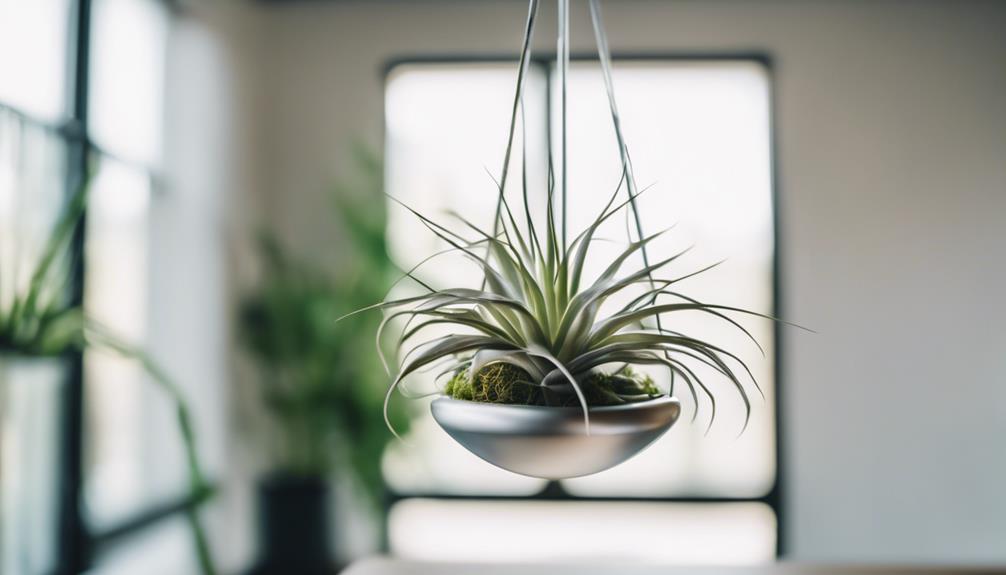
With modern air plant holders, we can elevate our space's aesthetic while showcasing our beloved plants in a stylish and sleek way. These holders come in a variety of designs and materials, offering endless possibilities for creative expression.
For instance, we can opt for a bundle set of 5 wood geometric air plant holders, each made of different species of wood and shapes. Alternatively, we can choose a handmade vase for flowers and farmhouse wall decor or a modern air plant holder set with a discount.
Some notable options include:
- A plant wall shelf for indoor and outdoor use with free shipping from WoodmadeCreation
- A hanging planter tube set made of glass for wall mounting and plant propagation from OdanaDesignStudio
- A handmade air plant holder set from PandemicDesignStudio with a 20% discount
- A geometric air plant holder made of wood from AnahataStringArtUA for a unique indoor wall decoration
Ceramic Wall Pocket Planters
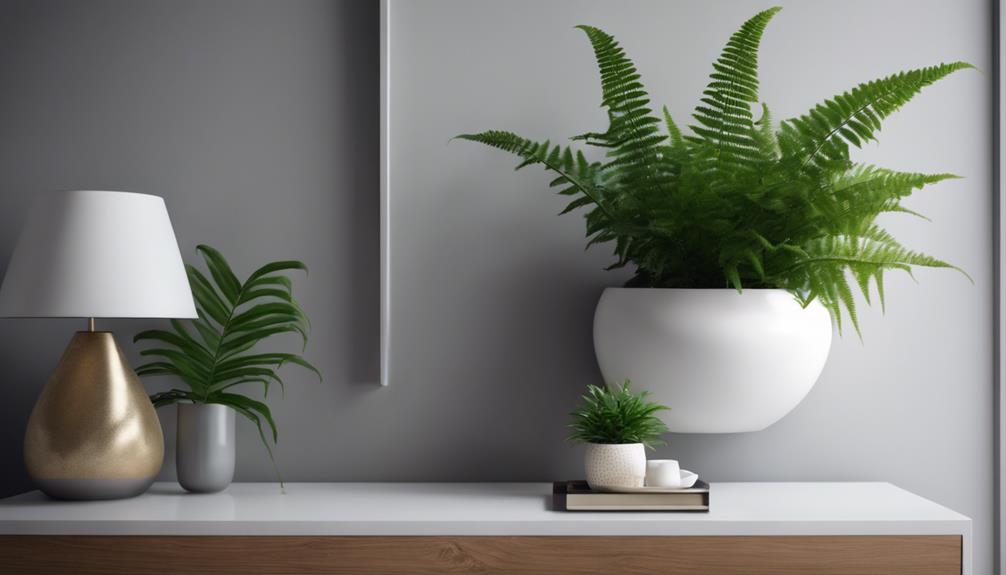
Ceramic wall pocket planters offer a stylish and space-saving solution for adding greenery to walls, allowing us to showcase our favorite small plants, succulents, herbs, or air plants in a unique way. These versatile hanging planters can be used indoors or outdoors, and their varied shapes, sizes, and colors guarantee they'll seamlessly fit into any decor style. We love that they provide a creative way to display our plants, adding a touch of nature to our walls without taking up valuable floor or shelf space.
When mounted on a wall, ceramic pocket planters create a beautiful plant wall that's sure to be a conversation starter. They're easy to install and can be arranged in a variety of patterns to create a stunning visual display. As wall-mounted planters, they're perfect for creating a green focal point in any room, drawing the eye upwards and adding depth to the space.
With their unique blend of style and functionality, ceramic wall pocket planters are an excellent choice for anyone looking to bring some natural beauty to their home or office.
Wood and Fabric Sconce Designs

As we explore wood and fabric sconce designs, we're drawn to the rustic charm they bring to any space.
We'll examine how rustic wood accents, fabric wrapped shades, and nature-inspired textiles come together to create a unique and cozy ambiance.
Rustic Wood Accents
We're drawn to rustic wood accents in plant sconces because they bring a warm, natural touch to any space, effortlessly blending with our existing decor. The combination of wood and fabric in sconce designs creates a cozy and inviting atmosphere, making them a perfect addition to our homes.
Here are some benefits of incorporating rustic wood accents in plant sconces:
- They add a touch of warmth and coziness to any room
- Handmade with premium wood, ensuring durability and a unique look
- Rustic wood accents enhance the overall aesthetic appeal of the decor
- They bring a natural element to our spaces, effortlessly blending with our existing decor
Fabric Wrapped Shades
We love how fabric wrapped shades bring a soft, warm glow to wood and fabric sconce designs, instantly elevating the ambiance of a room. These shades add a touch of softness and warmth to our sconces, making them a perfect addition to any space.
What's more, they can be customized with different fabric patterns and textures to match any decor style. This versatility allows us to play with color combinations and create visual interest in our sconce styling.
Another benefit of fabric wrapped shades is their ability to diffuse light, creating a cozy ambiance in a room. They offer a versatile option for incorporating unique and personalized elements into our sconce designs.
Nature-Inspired Textiles
Exploring natural elements in our wood and fabric sconce designs through nature-inspired textiles adds an organic touch to our spaces. We can bring the outdoors in by integrating wood and fabric designs that evoke a sense of nature.
For example, wooden plant wall decor can offer a rustic touch, while handmade rustic wood farmhouse sconces can serve as vases for flowers, enhancing our indoor decor.
Some options to explore include:
- Wooden plant wall shelves that provide a stylish display option for indoor and outdoor plants
- Handcrafted oak wood wall lamps and sconces that add a minimalist and modern touch to our home decor
- Modern air plant holders in a set of 3 small wall planters that provide a mid-century modern wall decor aesthetic
- Plant-inspired wall light designs that bring a touch of nature to our indoor spaces, perfect for hanging planters or adding some greenery to our walls
Unconventional Sconce Materials
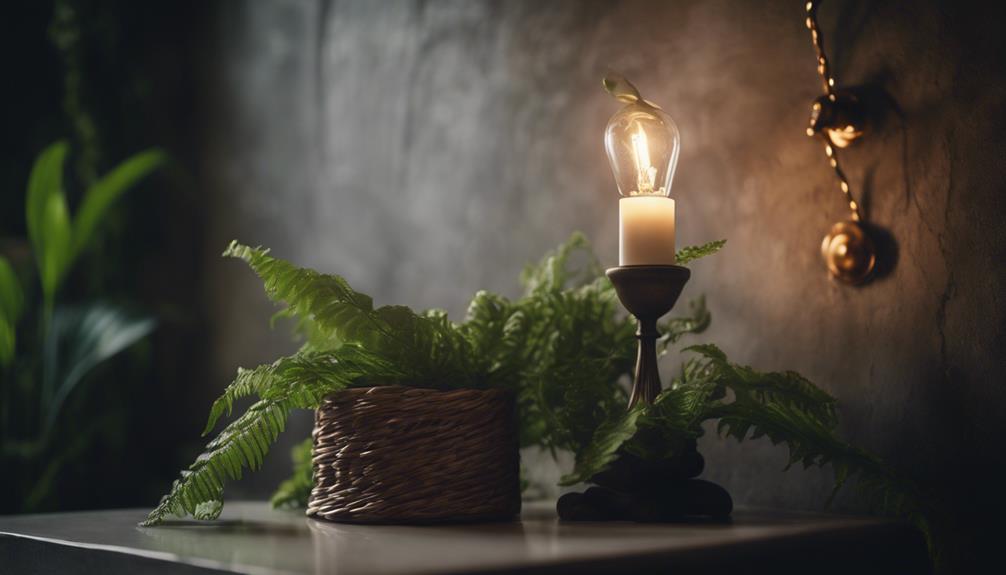
With a plethora of unconventional materials at our fingertips, we can craft unique plant sconces that inject personality into our indoor spaces. Ceramic, glass, metal, and wood offer diverse textures and finishes to complement different plant varieties.
By choosing unconventional materials, we can add a modern or rustic touch to our plant sconce styling. Ceramic sconces, for instance, provide a sleek and elegant look, while metal sconces offer a contemporary vibe. Mixing different materials can create a visually appealing and eclectic display for our plants.
In a home decor setting, a vertical garden featuring a combination of ceramic and metal sconces can add a touch of sophistication. By experimenting with unconventional materials, we can create a one-of-a-kind plant display that reflects our personal style.
Whether we opt for a sleek and modern or rustic and eclectic look, the right materials can elevate our plant sconce styling and take our indoor spaces to the next level.
Frequently Asked Questions
How Do You Decorate With Sconces?
We decorate with sconces by incorporating them into a gallery wall for a cohesive look.
We also use sconces to highlight artwork or photos by placing them on either side for balanced lighting.
Additionally, we create a cozy reading nook by installing sconces on either side of a bookshelf or above a comfy chair.
How to Style Floating Shelves With Plants?
As we explore the world of home decor, we find ourselves contemplating the art of styling floating shelves with plants.
We consider the importance of mixing trailing and upright plants to create visual interest, and the need to vary planter shapes, sizes, and materials for added texture.
How to Decorate a Wall With Plants?
As we consider how to decorate a wall with plants, we think beyond traditional hanging baskets and explore innovative approaches.
We can create a living wall by attaching planters or pockets to the wall, or use trellises to train vining plants upwards.
Do People Still Decorate With Sconces?
As we step into the world of home decor, we find ourselves pondering a timeless question: do people still decorate with sconces?
The answer is a resounding yes! Sconces continue to be a staple in many homes, offering a unique blend of functionality and aesthetic appeal.
With their versatility in design and styling options, it's no wonder they remain a popular choice for adding a touch of elegance and sophistication to any room.
Conclusion
As we conclude our journey through the world of creative plant sconce styling, we're left with a tapestry of vibrant colors, textures, and forms. The sconces, once mere fixtures, have transformed into living, breathing entities, as if the plants themselves have taken root in our imagination.
Like a painter's palette, our minds are now awash with possibilities, as the boundaries between art, nature, and design blur.
- About the Author
- Latest Posts
Introducing Ron, the home decor aficionado at ByRetreat, whose passion for creating beautiful and inviting spaces is at the heart of his work. With his deep knowledge of home decor and his innate sense of style, Ron brings a wealth of expertise and a keen eye for detail to the ByRetreat team.
Ron’s love for home decor goes beyond aesthetics; he understands that our surroundings play a significant role in our overall well-being and productivity. With this in mind, Ron is dedicated to transforming remote workspaces into havens of comfort, functionality, and beauty.
-

 Vetted2 days ago
Vetted2 days ago15 Best Printers of 2024: Top Picks and Expert Reviews
-

 Vetted4 days ago
Vetted4 days ago15 Best Tile Sealers for Long-Lasting Protection and Shine
-

 Vetted1 week ago
Vetted1 week ago15 Best Smelling Floor Cleaners That Will Leave Your Home Fresh and Inviting
-

 Vetted6 days ago
Vetted6 days ago14 Best Power Scrubbers for Showers That Will Transform Your Cleaning Routine
-

 Mardi Gras Decoration1 day ago
Mardi Gras Decoration1 day agoWhat Do the Symbols of Mardi Gras Mean?
-

 Appliances4 days ago
Appliances4 days ago5 Best Energy-Efficient Stainless Steel Fridges 2023
-
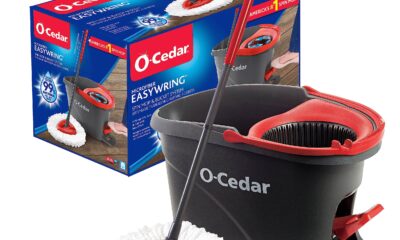
 Vetted4 weeks ago
Vetted4 weeks agoBest Mop for Sparkling Clean Floors in 2024
-
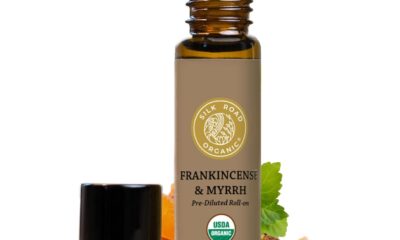
 Vetted4 days ago
Vetted4 days agoBest Essential Oil Brand: Top Picks for 2024






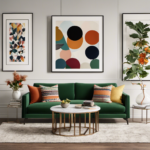
















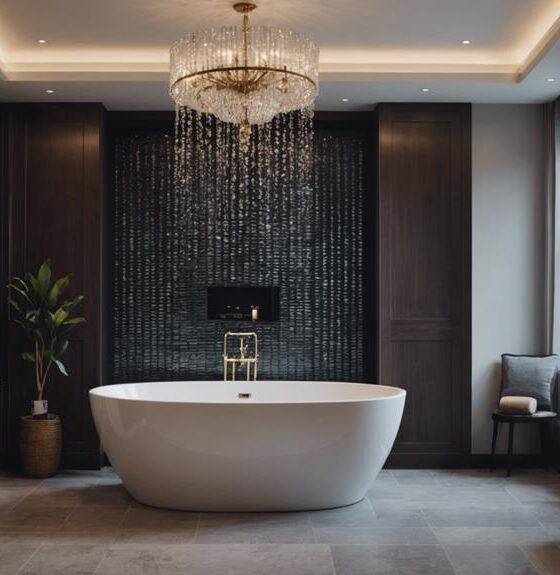


![Best Murphy Bed Options for Small Spaces [2024] 167 81VUhrTjgqL](https://byretreat.com/wp-content/uploads/2023/11/81VUhrTjgqL-400x240.jpg)
![Best Murphy Bed Options for Small Spaces [2024] 168 81VUhrTjgqL](https://byretreat.com/wp-content/uploads/2023/11/81VUhrTjgqL-80x80.jpg)



![Best Floor Cleaner for Sparkling Clean Floors [2024] 171 81jJS17Y4IL 2](https://byretreat.com/wp-content/uploads/2023/11/81jJS17Y4IL-2-80x80.jpg)